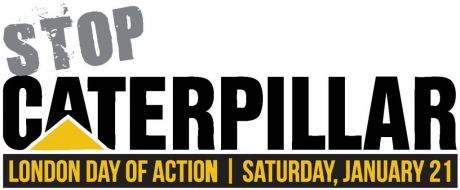Features
You are here
Bulldoze Caterpillar Inc.

January 12, 2012
Just as the Canadian Centre for Policy Alternatives reported that Canada’s top CEOs make as much in a few hours as the average worker makes in a year, the huge multinational Caterpillar Inc. locked out 465 employees at its London Electro-Motive Diesel facility.
Despite making a whopping $32 billion last year, the company has demanded massive concessions from its London workers, who are members of the Canadian Auto Workers (CAW): a $21-million reduction in wages, a $1.5-million cut in benefits, and $6.9 million off their pensions. This amounts to a devastating wage rollback of more than 50 per cent: from $35 an hour to $16.50.
Global 1%
It’s clear that Caterpillar is following the lead of the Big Three automakers, INCO, US Steel and other huge multinationals in forcing workers to increase the coffers of the 1%. Caterpillar is also profiting from the occupations of Afghanistan and Palestine. For example, it provides the bulldozers used to demolish Palestinian homes and olive groves.
Caterpillar is trying to claim poverty in order to impose concessions on its employees, but in 2009, its former CEO, J.W. Owens, took home $8.75 million. In 2010, the top eight executives pocketed a total of over $67 million—more than three times the cuts demanded from the London employees.
This has nothing to do with Caterpillar being “foreign owned.” Caterpillar has just as bad a history fighting American unions. In 1996, it forced out many of its US employees on a 17-month strike. Furthermore, Caterpillar could never get away with its current attack on London workers without the complicity of Canada’s 1%.
For example, in 2010, the Harper Tories encouraged Caterpillar to buy out Electro-Motive Diesel, giving the company $5 million in tax incentives, along with a potential $1 billion in investment breaks. Workers are furious at the Harper government for rewarding a corporation that attacks its workforce. The Tories were quick to intervene in other labour disputes, stripping airline and postal employees of their right to strike. But they won’t intervene to force Caterpillar to end its lockout, preferring instead to take sides with the 1%.
Workers’ control
The lockout has the potential to galvanize the labour movement, which must learn the lessons from previous attempts to resist concessions.
In the 1990s, Caterpillar announced the closure of a manufacturing facility in Toronto. Instead of just accepting the closure, CAW members along with environmental activists launched a Green Jobs Coalition and occupied the plant. They demanded that the provincial government take over the plant and convert it into a facility to manufacture environmentally friendly products. Although they didn’t win their demands in the end, their struggle helped raise the prospect of building unity between labour and other allies, and inspired others to fight closures and layoffs.
Actions like this one could be even more effective today, given the popularity of the Occupy movement and the growing anger at the 1%. Occupying a plant or workplace has the potential to stop the cuts, and could attract widespread support from the public, who are sick of a system that only benefits the rich.
Another important lesson is avoiding the trap of begging governments to bail out companies—with no strings attached. This should be clear from the Caterpillar experience and from news that Chrysler is looking for even more concessions from CAW members. The logic that corporate tax cuts and generous subsidies for profitable companies will save or create jobs has shown itself to be false. Instead, it simply allows the Harper Tories to hand out money to the 1%, as they did with Caterpillar. When companies threaten bankruptcy, unions should respond by arguing for factories to be nationalized, but under the control of the workforce.
‘A line in the sand’
Caterpillar’s announcement came in the midst of December holidays, but that didn’t stop labour activists from showing solidarity. Trade unionists from other sectors joined CAW members to stop the potential use of scabs. Sid Ryan, the recently re-elected president of the Ontario Federation of Labour (OFL), quickly called on labour to build a solidarity rally and march in London on January 21.
Buses are coming from as far away as Ottawa. In addition, the call for solidarity has inspired Occupy activists to support locked out workers. Occupy London was soon on the picket lines, while other Occupy groups have sent solidarity messages.
CAW members use the slogan “a line in the sand” to show that they won’t back down to defend workers’ basic rights. Today more than ever, that line needs to be drawn. Private sector employers have been on the offensive, and now both public sector employees and public services are under attack from all levels of government.
The past three years have seen some courageous battles by workers against corporate greed—INCO, US Steel, York Transit and others. More recently, the Arab Spring and the Occupy movement have inspired a broader resistance against the global 1%. Together these movements have the power to stop the 1%—especially in the workplace, where profits are generated. That’s why it’s important that everyone mobilize for London on January 21, and push the union leadership at all levels to “draw a line in the sand.”
For more details, visit http://bit.ly/yLP7kN and http://bit.ly/xUrfiJ
Section:
- Log in to post comments










